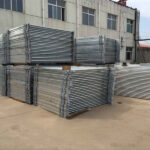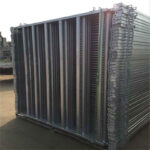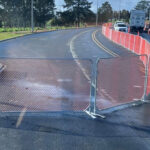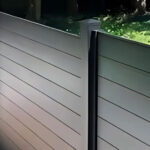باعتبارك محترفًا في مجال البناء، فإن فهم كيفية تقديم العطاءات لمشاريع الأسوار الحاجزة حول مواقع البناء أمر بالغ الأهمية لتأمين المشاريع المربحة وضمان سلامة الموقع. سيرشدك هذا الدليل الشامل خلال عملية تقديم العطاءات لمشاريع الأسوار المؤقتة، من التقييم الأولي إلى تقديم الاقتراح النهائي. دعنا نغوص في عالم سياج مؤقت وتعلم كيفية إنشاء عروض رابحة تتميز عن المنافسين.
فهم أهمية الأسوار الحاجزة
قبل أن نخوض في عملية تقديم العطاءات، من الضروري أن ندرك أهمية الأسوار الحاجزة في مواقع البناء. تخدم هذه الهياكل المؤقتة أغراضًا متعددة:
- أمان:تعمل الأسوار الحاجزة على حماية العمال والمارة من المخاطر المحتملة.
- حماية:إنها تمنع الوصول غير المصرح به إلى موقع البناء.
- امتثال:تتطلب العديد من الولايات القضائية وجود أسوار حاجزة كجزء من لوائح البناء.
- الاحترافية:إن السياج الذي يتم صيانته جيدًا يعزز صورة المشروع.
مع وضع هذه العوامل في الاعتبار، دعونا نستكشف الخطوات اللازمة لإنشاء عرض مقنع لتثبيت سياج الحاجز.
تقييم متطلبات المشروع
الخطوة الأولى في كيفية تقديم العطاءات الخاصة بأعمال الأسوار الحاجزة حول مواقع البناء هي إجراء تقييم شامل لمتطلبات المشروع. ويتضمن ذلك:
- زيارة الموقع:إجراء فحص مادي لموقع البناء لفهم تخطيطه والتحديات الفريدة التي يواجهها.
- قياس المحيط:قم بقياس محيط الموقع بدقة لتحديد إجمالي السور المطلوب.
- تحليل التضاريس:تقييم حالة الأرض، والتي قد تؤثر على طرق التثبيت والتكاليف.
- نقاط الوصول:تحديد مواقع البوابات ومداخل المشاة.
- مدة:تحديد الجدول الزمني للمشروع ومدة السياج المطلوبة.
"يعتبر التقييم الشامل للموقع هو الأساس للعطاء الدقيق والتنافسي." – خبير سلامة البناء
اختيار مواد السياج المناسبة
يعد اختيار مواد السياج المناسبة أمرًا بالغ الأهمية من أجل السلامة والفعالية من حيث التكلفة. ضع في اعتبارك الخيارات التالية:
- لوحات سلسلة الوصلات:متينة وفعالة من حيث التكلفة لمعظم مواقع البناء.
- سياج البناء المؤقت:تم تصميمه خصيصًا للاستخدام قصير المدى مع سهولة الإعداد والإزالة.
- لوحات الارتباط:متعدد الاستخدامات وسهل إعادة التكوين مع تطور الموقع.
- خيارات للخدمة الشاقة:للمواقع التي تحتاج إلى مزيد من الأمن أو تعاني من ظروف جوية قاسية.
| نوع السياج | الايجابيات | سلبيات |
|---|---|---|
| سلسلة الوصل | بأسعار معقولة، ومتعددة الاستخدامات | أقل جاذبية بصريا |
| البناء المؤقت | إعداد سريع، محمول | قد يتطلب المزيد من الصيانة |
| لوحات الارتباط | قابلة لإعادة التكوين بسهولة | تكلفة أولية أعلى |
| الثقيلة | تعزيز الأمن | أغلى ثمنا وأصعب في النقل |
حساب تكاليف المواد والعمالة
إن تقدير التكلفة بدقة أمر ضروري للحصول على عرض تنافسي. ضع في اعتبارك ما يلي:
- مواد السياج:احسب التكلفة الإجمالية للألواح والأعمدة والملحقات.
- تَعَب:قم بتقدير الساعات المطلوبة للتثبيت والإزالة.
- تأجير المعدات:تتضمن تكاليف أي آلات ضرورية.
- مواصلات:ضع في اعتبارك تكاليف التسليم والإزالة.
- صيانة:ضع في اعتبارك تكاليف الصيانة المستمرة طوال مدة المشروع.
نصيحة احترافية:لا تنسَ أن تأخذ في الاعتبار التأخيرات المحتملة المتعلقة بالطقس أو التحديات الخاصة بالموقع والتي قد تؤثر على تكاليفك.
مع الأخذ بعين الاعتبار الظروف الجوية ومواصفات الموقع
الظروف الجوية ويمكن أن تؤثر العوامل الخاصة بالموقع بشكل كبير على عرضك. ضع في اعتبارك ما يلي:
- التعرض للرياح:قد تتطلب المناطق ذات الرياح العاتية دعامات إضافية أو سياجًا أثقل.
- حالة التربة:قد تتطلب التربة الرملية أو الصخرية تقنيات تركيب خاصة.
- التغيرات الموسمية:خذ في الاعتبار كيفية تأثير أنماط الطقس على عملية التركيب والصيانة.
- البيئة المحيطة:قد يكون للبيئة الحضرية متطلبات وتحديات مختلفة.
دمج تدابير السلامة
يجب أن تكون السلامة على رأس أولوياتك في عرضك. يجب أن يتضمن العرض أحكامًا تتعلق بما يلي:
- اللافتات المناسبة:علامات التحذير وشاشات عرض معلومات المشروع.
- تحسينات الرؤية:شريط عاكس أو إضاءة لظروف الإضاءة المنخفضة.
- التفتيشات الدورية:فحوصات مجدولة لضمان سلامة السياج طوال المشروع.
- إصلاحات الطوارئ:خطة لإصلاحات سريعة في حالة حدوث ضرر.
صياغة مقترح شامل
يجب أن يكون عرضك واضحًا ومفصلاً واحترافيًا. يجب أن يتضمن:
- الملخص التنفيذي:نظرة عامة موجزة عن فهمك للمشروع والحل المقترح.
- نطاق العمل التفصيلي:حدد بوضوح ما هو المدرج في العرض الخاص بك.
- قائمة المواد:حدد أنواع وكميات الأسوار وملحقاتها.
- خطة التثبيت:صف نهجك في الإعداد والإزالة.
- الخط الزمني:توفير جدول للتثبيت والصيانة والإزالة.
- تفاصيل التكلفة:قم بتفصيل جميع النفقات لتحقيق الشفافية.
- مؤهلات الشركة:أبرز خبراتك ومهاراتك في مجال السياج المؤقت.
- مراجع:تتضمن شهادات أو معلومات الاتصال للعملاء السابقين.
الاستفادة من التكنولوجيا لتحقيق الميزة التنافسية
دمج التكنولوجيا الحديثة لتعزيز عرضك:
- التصور ثلاثي الأبعاد:استخدم برنامجًا لإنشاء تمثيل مرئي لمخطط السياج المقترح.
- أدوات إدارة المشاريع:أظهر قدرتك على تتبع التقدم والتواصل بشكل فعال.
- التوثيق الرقمي:تقديم تحديثات وتقارير في الوقت الفعلي طوال فترة المشروع.
معالجة المخاوف البيئية
أظهر التزامك بالاستدامة:
- المواد القابلة لإعادة التدوير:تسليط الضوء على استخدام خيارات السياج الصديقة للبيئة.
- تأثير ضئيل على الموقع:اشرح كيف تحمي طرق التثبيت الخاصة بك البيئة المحيطة.
- خطة الحد من النفايات:تحديد الاستراتيجيات اللازمة لتقليل النفايات أثناء المشروع.
توفير خدمات ذات قيمة مضافة
ميّز عرضك من خلال تقديم خدمات إضافية:
- دعم 24/7:نعد بتقديم المساعدة على مدار الساعة في حالات الطوارئ.
- العلامة التجارية المخصصة:عرض دمج شعار العميل أو الألوان في تصميم السياج.
- المرونة:أكد قدرتك على التكيف مع احتياجات المشروع المتغيرة.
إتمام وتقديم عرضك
قبل التقديم، قم بهذه الخطوات النهائية:
- المراجعة والتنقيح:قم بمراجعة اقتراحك بعناية للتأكد من عدم وجود أخطاء أو لغة غير واضحة.
- احصل على رأي ثانٍ:اطلب من أحد زملائك مراجعة عرضك للتأكد من اكتماله وقدرته التنافسية.
- الاستعداد للأسئلة:توقع استفسارات العملاء المحتملين وكن مستعدًا للإجابات التفصيلية.
- التسليم في الوقت المحدد:تأكد من وصول عرضك إلى العميل قبل الموعد النهائي.
خاتمة
يتطلب إتقان كيفية تقديم العطاءات الخاصة بالأسوار الحاجزة حول مواقع البناء مزيجًا من المعرفة الفنية والخبرة العملية والتفكير الاستراتيجي. باتباع هذا الدليل الشامل، ستكون مجهزًا جيدًا لإنشاء عطاءات مقنعة تبرز خبرتك وتفوز بمزيد من العقود. تذكر أن مفتاح النجاح يكمن في التحضير الشامل والاهتمام بالتفاصيل والالتزام بالسلامة والجودة.
الأسئلة الشائعة
ما هو متوسط التكلفة لكل قدم طولي للسياج الإنشائي المؤقت؟ يمكن أن تختلف التكلفة بشكل كبير حسب نوع السياج ومتطلبات المشروع، ولكنها تتراوح عادةً من $3 إلى $15 لكل قدم طولي. تؤثر عوامل مثل جودة المواد وظروف الموقع ومدة المشروع على السعر النهائي.ما المدة التي يستغرقها تركيب سياج مؤقت حول موقع بناء عادةً؟ يعتمد وقت التركيب على حجم الموقع وتعقيده، ولكن يمكن لفريق محترف عادةً تركيب سياج بطول 300 إلى 500 قدم خطي يوميًا. قد تستغرق المشاريع الأكبر عدة أيام حتى تكتمل.هل هناك أي قواعد محددة يجب أن أكون على علم بها عند تقديم عطاءات لأعمال سياج الحاجز؟ تختلف القواعد حسب الموقع، ولكن المتطلبات الشائعة تشمل الحد الأدنى لارتفاع السياج (عادة 6 أقدام)، والبناء القوي، واللافتات المناسبة. تحقق دائمًا من قوانين البناء المحلية وإرشادات إدارة السلامة والصحة المهنية قبل تقديم عطاءك.ما هي بعض الأخطاء الشائعة التي يجب تجنبها عند تقديم عطاءات لأعمال سياج الحاجز؟ تشمل الأخطاء الشائعة التقليل من تقدير تكاليف المواد، والفشل في حساب التحديات الخاصة بالموقع، وعدم تقديم نطاق عمل واضح ومفصل. قم دائمًا بإجراء زيارة شاملة للموقع وتحقق من حساباتك مرتين قبل تقديم عرض.كيف يمكنني أن أجعل عرضي لسياج الحاجز يبرز بين المنافسين؟ ركز على إبراز نقاط القوة الفريدة لشركتك، مثل أوقات الاستجابة السريعة، والمواد عالية الجودة، أو تقنيات التثبيت المبتكرة. بالإضافة إلى ذلك، فإن التأكيد على سجل السلامة الخاص بك وتقديم أسعار مفصلة وشفافة يمكن أن يمنحك ميزة.من خلال الإجابة على هذه الأسئلة الشائعة، ستكون مستعدًا بشكل أفضل للتنقل في عملية تقديم العطاءات وتأمين المزيد من عقود الأسوار الحاجزة لشركتك.









